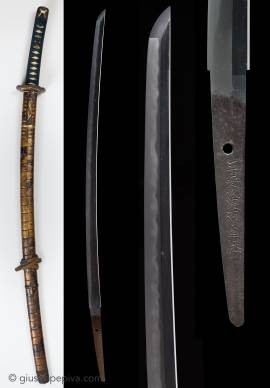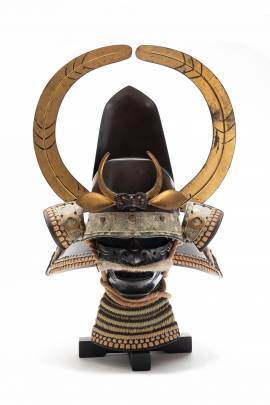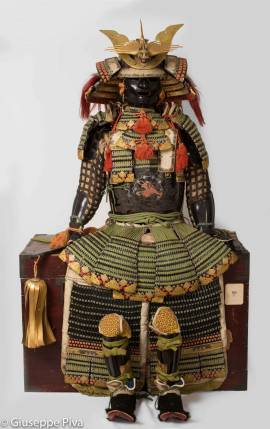Shinto Kunitsugu KatanaSigned Heianjō Fujiwara Kunitsugu平安城藤原国継Edo Period, Circa 1720NBTHK Tokubetsu Hozon Tōken Nagasa [lenght]: 70 cmMotohaba: 2,9 cm, sakihaba: 1,8 cmSugata [configuration]: shinogi-zukuri, koshi-zori, iori-mune, small chu-kissakiKitae [forging pattern]: itame mixed with mokume hada, clear jinieHamon [tempering pattern]: gunome-choji in tight nioi-deki; ashi, yō and sunagashiBōshi [point]: komaruNakago [tang]: ubu, Sujikai yasurime; one mekugi-anaOrigami: the blade comes with a Tokubetsu Hozon Tōken (SwordParticularly Worth of Preserving) certificate issued by the...
WORKS FOR SALE
Samurai helmet in the shape of a court capEdo Period, 18th century Helmets shaped as a tōkanmuri, a ceremonial lacquer hat worn at the Chinese court by literati and statesmen, were quite popular among samurai by the end of the 16th century. Of the many variations on the theme, this one is quite rare, with a pointed tip and flat faces on the rear. The wakidate, side ornaments which normally resemble the long wings on the cap’s back, are here shaped as hawk’s feathers. Fine elements on this helmet, like the engraved shakudo borders and the stencilled leather with fusegumi...
Samurai armor bearing the kamon of Inaba familyMid to late Edo period (1615 - 1867)Kabuto bachi signed “Masuda Myochin Minbu Ki no Munesada Saku” and dated February 1757Provenance:Iyo no kami Inaba clan This very important authentic samurai armor is complete and original. It is entirely made of hon-kozane plates (individual scales) and bears gilt metal engraved kanamono all over its parts; interiors are lacquered in gold, a sign of a very high level provenance.The armor comes with a wide series of accessories: it includes two pairs of suneate (one heavier and one very...
Copyright © 2016 - giuseppe piva - VAT: 05104180962










